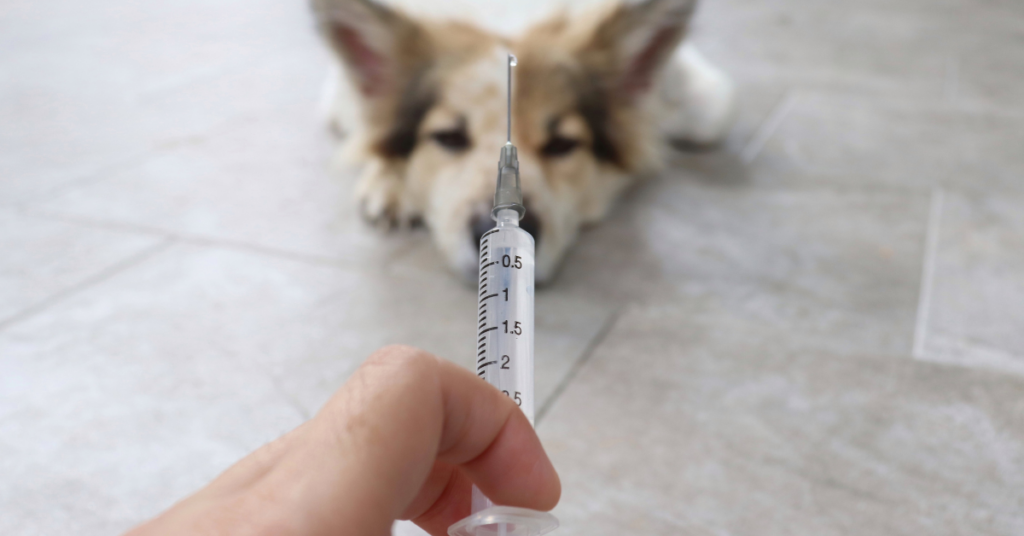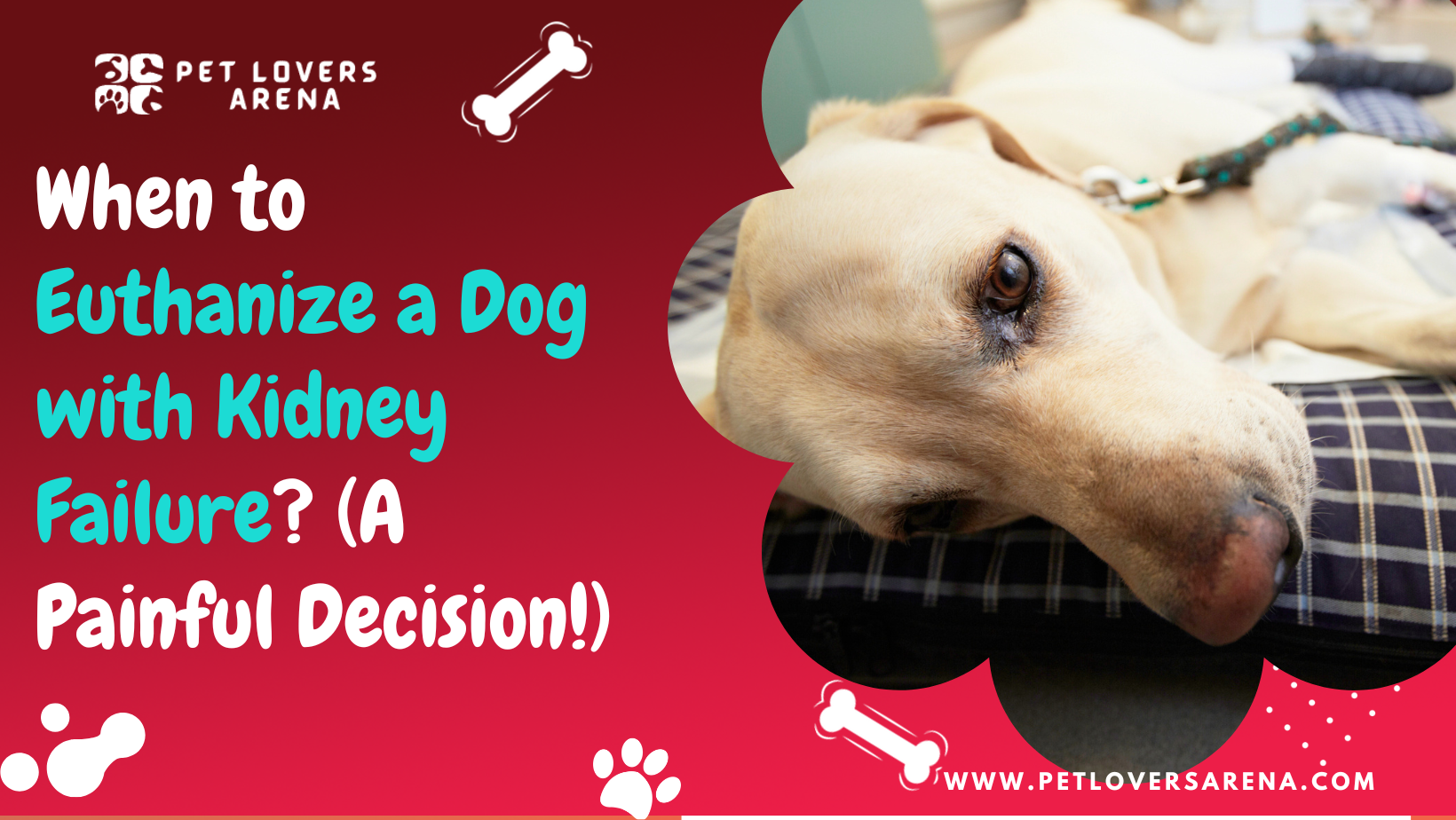The best way to keep your dog healthy is to find the early signs of illness and consider treatment as soon as possible. Unfortunately, euthanizing your dog is one of the most difficult steps for any dog owner that he will ever take.
Canine kidney failure is a common problem faced by many dogs. The unfortunate thing is that it can go unnoticed for a long time before it starts showing its symptoms.
Euthanizing a dog is the hardest step, and you need to consider all the possible methods for your dog’s recovery before making this decision. Consider asking the veterinarian about the possible treatments and when it is the right time to euthanize your dog.
Here in this article, we will learn about the problem of canine kidney failure and when to take the necessary step of euthanizing the dog.
Kidney Failure in Canines
Chronic kidney failure or kidney failure in canines is the inability of the kidneys to filter the blood and remove waste products from the blood in your dog. Most dogs with kidney failure can produce large quantities of urine, but the toxic waste does not get eliminated.
Canine kidney failure is a common problem in older dogs, but due to their old age factor, this problem often remains unnoticed for a long time. This disease often progresses slowly and occurs in dogs when the dog eats some toxic substance like antifreeze or is given poison.
Acute kidney failure can lead to decreased blood flow or oxygen delivery to the body. The decreased blood flow and oxygen delivery can further worsen the condition of dogs. Long-term kidney disease in dogs leads to irreversible kidney failure that is not treatable.
Many other factors can be responsible for this condition in dogs, including long-term consumption of medications like antibiotics, chemotherapy drugs, cysts in the kidneys, etc.
Signs And Symptoms of Kidney Failure in Dogs

The most common symptom you can notice in dogs suffering from kidney failure is increased thirst and urination, as the dog’s body requires more fluids due to damage to the kidney’s tissues. Here are some symptoms you can look for in your dog suffering from chronic kidney failure.
- Pale, dry gums– the gums become dull and dry to the touch.
- Dogs lose interest in food and do not have as much food as usual.
- Excessive shedding—with a dull coat, the coat becomes less shiny, and there is excessive shedding.
- Bloodshot eyes– the white parts of the dog’s eyes become red.
- Weight loss– The dog starts looking weak and losing weight significantly, gradually losing fat and muscle mass.
- Lethargy – with no desire to move, the dog spends most of his time sitting.
- Increased sleep – with only brief periods of wakefulness, the dog spends most of the time sleeping.
- Vomiting—unable to keep food down, the dog vomits whatever it eats.
- Dogs are clumsy and disoriented the majority of the time.
- Trembling: You will notice your dog having seizures regularly, which is a major indicator that the dog suffers from kidney failure.
- Breathing difficulties: unable to breathe normally, the dog starts taking deep breaths.
- Mouth ulcers—these ulcers are raw and extremely painful for your dog.
There are other symptoms also that only the vet will be able to test for in the clinic, and these symptoms include:
- The excessive buildup of waste products in the body is another sign of kidney failure, recognized by the vet after diagnosis.
- Anemia – It means a lack of iron in the blood and is a common symptom of kidney failure.
- High blood pressure—during kidney failure, the dog’s blood pressure shoots up.
- Slow heart rate—a faster heart rate will slowly turn to a slower one during the end stage of kidney failure, indicating that it is time to euthanize the dog.
Treatment For Kidney Failure
To treat your dog’s kidney failure, the vet will suggest a change in diet. A lower sodium and phosphorus diet can help slow down kidney failure.
To reduce kidney inflammation, give your dog some natural supplements like omega-3 fatty acids, which we can usually get from fish oil. In addition, vitamin C and B complexes can help stimulate appetite and replenish vitamin deficiency.
Alternative medications for kidney failure treatment include ACE inhibitors, which reduce stress and offer your dog a better quality of life.
Along with conventional treatment, you can give your dog acupuncture treatment or natural flower essence regularly, as it has proven helpful in the progression of kidney failure.
When Should You Euthanize a Dog With Kidney Failure?

If you are considering euthanizing your dog, you should consider the veterinarian first. Only the vet will be able to advise you on the right step that you should take at this moment.
When you seek advice, guidance from the vet should be the first choice you should make, rather than going to other people for advice. Consider the vet and carefully consider all the options, whether they are medications or surgery, that you have to use to treat your dog.
The professional veterinarian may be aware of advanced treatment measures that many others are unaware of or are not available online; therefore, considering the vet is critical at this time.
Most vets will look for any sign of discomfort or pain that your dog is experiencing. That can help them to know what exactly your dog is suffering from and what can be the possible treatment.
In addition, your dog’s vet will look for certain signs and symptoms that tell you about the disease your dog is facing and at what stage the dog is in. But, of course, the signs can vary from one dog to another depending upon the stage of their illness and the kind of problem your dog is facing.
Here are some symptoms that you can look for in your dog to know if the dog is facing any discomfort due to kidney failure:
- You will notice your dog has increased their water intake. Along with this, you will notice frequent urination in your dog.
- You may notice frequent vomiting and regular diarrhea in your dog.
- Your dog can face difficulty in locomotion, either if the dog is limping or in pain.
- Your dog has a reduced appetite and is not eating as much as it usually does.
- Breathing issues and decreased energy are signs of a problem your dog faces.
- Look closely at different body parts, like their mouth, skin coat, gums, etc.
- Decreased heart rate and high blood pressure are signs of end-stage renal failure in your dog.
Euthanization of the dog is an argument in its own right. However, you first need to consider all the possible ways in which you can protect and treat your dog. If there is still no option left, then decide to euthanize the dog after proper consideration from the vet.
You May Know About: When To Euthanize A Dog With Liver Failure? (Vet’s Advice)
Why Does Kidney Failure Happen in Dogs?
The main culprit for kidney failure in dogs is aging. As the dog ages, things, especially its organs, don’t work as well as they used to work at a young age, and thus mostly, they fail.
Congenital disabilities, bacterial infections, and poison can also be the reasons for kidney failure in dogs. People often consider that the cause of chronic kidney failure in dogs is unknown, but age plays an important role in kidney failure in dogs.
With age or time, your dog’s renal tissues start to damage and cannot perform their usual function. Kidney failure and kidney tissue damage are also related to your dog’s size. A dog with a large size has kidney problems during the 7th or 8th year of life, while small dogs have a long lifespan, so they have this issue at the later stage of their life.
What Are the Early Signs of Kidney Failure in Dogs?

The most common signs of kidney failure include your dog consuming a lot of water and going for frequent urination. There can also be many other signs like trembling, seizures, pale gums, etc., that have already been picked up in this article.
Your dog will start showing these signs when nearly two-thirds of your dog’s kidney tissue has been damaged. When you start seeing these signs in your dog, it means it has been quite some time since your dog has been ill, and you need to take immediate steps to help it.
To cope with this and help your dog recover, you need to take your dog for a regular checkup every 7 to 8 months.
Is it Possible to Completely Treat a Dog’s Renal Failure?
“Yes and no too.” Just like in humans, if you can detect the renal failure in dogs at an early stage, then you can treat this condition in your dog. However, if you find it at a later stage, then you will not be able to treat this renal failure condition in dogs.
The dog will most likely live a happy life if you find this problem of renal failure in dogs in the early stages, but if you find it in the later stages and the kidney’s tissues are badly damaged, you will not be able to treat your dog.
The veterinarian prefers to give your dog an altered diet or a diet low on sodium and phosphorus while checking your dog’s vitamins and mineral requirements. You can also give passive or stress reduction treatment to your dog for quick recovery.
Your dog’s vet can also give you some medications as per your dog’s needs.
These medications may include subcutaneous fluids and blood pressure medications as per your dog’s body needs.
If you want a happy and stress-free life, you must be extra careful about your dog’s health. Since chronic kidney failure is a disease that will be with your dog until the end, you must be careful with your dog in the future. Being careful doesn’t mean your dog can’t have a normal life.
If your dog is at the last stage of kidney failure, you can’t do much about it as the condition at this stage is non-treatable. The advice professionals will give you is to keep your dog as comfortable and stable as possible.
Although it is highly advisable to keep your dog’s bed comfortable, as a dog’s owner, you know your dog’s likes and dislikes, and you need to make efforts according to this. Try to make the final days with your dog happy and comfortable as much as possible.
How Long Can a Dog With Stage 4 Kidney Failure Live?

There are different stages of renal failure or kidney failure in dogs. If you diagnose your dog in the first or second year of kidney failure, then the life expectancy for your dog is months to years.
Unfortunately, on the other hand, if you diagnose your dog with kidney failure at the last stage or stage 4 of this disease, then the life expectancy remains only a few weeks. So if the dog is suffering from stage 4 kidney failure and your dog’s health keeps getting worse, you need to decide on the tough step of euthanizing your dog soon to help your dog get rid of the pain.
What About Euthanization in The Final Stage?
Euthanization of the dog is the hardest step any dog owner will ever take, but when you know nothing else can be done, there is no option left. So when is the time to euthanize the dog?
You have to consider euthanization when you have tried all the possible treatments you could (don’t exhaust your dog with too many treatments), and there is no positive response to the treatments. Again, it is about the quality of life that you can afford for your dog at the last minute of its life.
Why Would I Consider Euthanization For My Dog Suffering From Kidney Failure?
If your dog’s health is deteriorating daily and constantly suffering from pain or illness, and the quality of life is miserable, you should consider euthanizing. However, keeping your dog alive just for yourself and not considering your dog’s pain is not what you should ever do.
Euthanizing your dog is not about no more wanting the dog but putting it to sleep comfortably and ending its suffering. So, consider your dog’s feelings and everything he is going through, and consider the next step of euthanizing the dog for your dog’s well-being.
What Are the Other Signs Indicating My Dog is Suffering?
Suffering is not only physical; it also means that during illness, your dog might be suffering from depression. The obvious signs of your dog suffering physically and mentally include being very less active and spending a lot of time sleeping or being too passive.
Your dog’s not eating and drinking, sleeping too much, not being able to go to the toilet alone, etc., can clearly show that it is suffering physically and mentally. Depression is as bad as a physical illness like kidney failure and can badly affect your dog’s health.
Remember to Consider the Cost of Treatment

Sometimes there can be a treatment available, but you are not financially capable enough to get the treatment or someone who could help you financially.
If there is no way that your dog can live a pain-free and happy life without the treatment, you should consider euthanizing your dog.
But still, before euthanization, you can go to the vet and consider all the possible payment methods for treating your dog.
With the cost of pet care rising today, it is heartbreaking when you cannot treat the dog. However, if you are worried about your dog getting sick and cannot raise enough money for your dog’s treatment, you can consider a pet insurance policy to help your dog.
Pet insurance can be as low-cost as $10 per month, but there are high-cost investment plans also. In addition, you can invest according to your budget, giving yourself peace of mind.
The monthly cost goes up with your dog’s age, so you should get pet insurance as early as you can afford it.
Is Euthanization of the Dog a Cruel Choice to Make?
The answer to this depends upon whom you ask the question. If you decide to euthanize your dog at a particular date and time and you are not able to give your dog a good quality of life, then euthanizing your dog is the only option you have, and you can spend quality time with your dog till that time.
Euthanization of a dog is a controlled, monitored, and less cruel method than letting your dog live through bad days being unwell and suffering physically and mentally. Letting your dog live by being extremely unwell is what we call cruel, and letting your dog be euthanized is not what we consider cruel.
What Happens During the Euthanasia of the Dog?
The process of euthanization consists of two shots, one that has a sedative in it and another one that contains the euthanasia drug. The euthanasia drug may sound scary to you, but it is the medication that puts your dog to sleep quickly.
The vet usually prefers the pentobarbital medication, which is a seizure medication for euthanization. This medication puts your dog to sleep quickly as it shuts down the brain function and heartbeat within 2 to 3 minutes.
Irrespective of what you think, this procedure doesn’t cause your dog any pain. You may notice your dog twitch slightly or not completely close its eyes, but this is a normal part of the procedure.
What If I Decide to Euthanize My Dog?

Losing a pet is like losing a loved one; you will need someone to walk you through this phase. Talk to a professional or vet for advice. Also, consult your family and friends, not for advice but for consolation.
You can also look for literature or some books available online, where you will find numerous ways to deal with pet loss.
You can find support groups on social media channels like Facebook, Instagram, Twitter, etc., where you can get all the information and first-hand experience of when to euthanize your dog, what precautions you should take, and how to deal with the loss of your pet after euthanization.
Conclusion
The euthanization of your dog is the hardest step you will ever take. But considering the dog’s health and mental and physical suffering, this is sometimes the only option left in hand.
So before you decide to euthanize your dog, consider all the possible treatment options you have in your hand at the moment. It would be best if you took advice from professionals and not others as it can affect your decision in a wrong way too.
Euthanization may sound cruel to some, but if we consider the dog’s suffering, this will be the sanest step taken by the owner. But before deciding on a dog’s euthanization, it is best to look at all the available options.
Meet Fabian Wright, our guide into the animal realm at PetLoversArena.com. Having served as an Animal Care Specialist for the Ruwenzori Team at the Kansas City Zoo, he prioritizes conserving exotic species by replicating their habitats. Fabian aspires to share captivating stories of creatures, big and small, through PetLoversArena.com.

